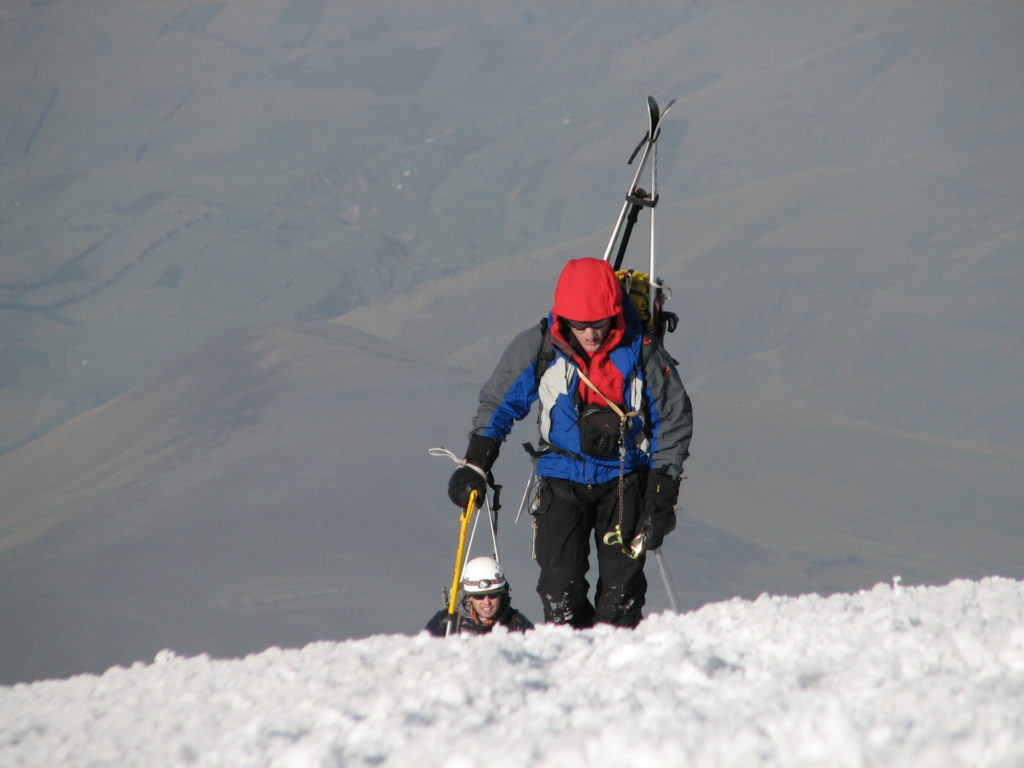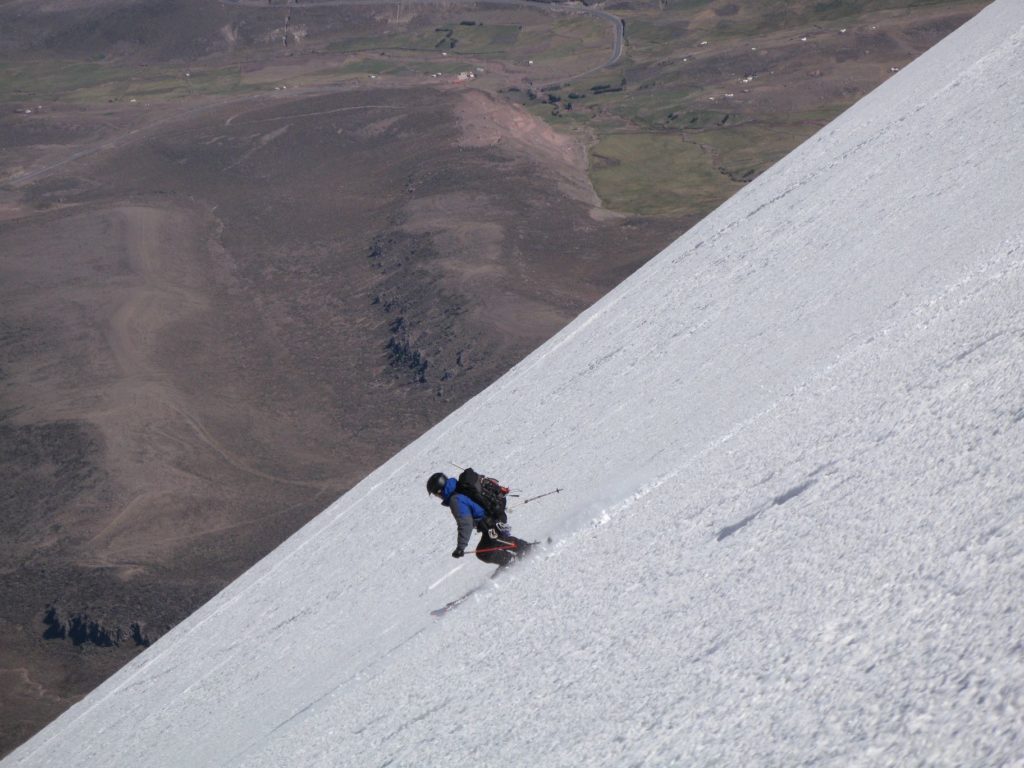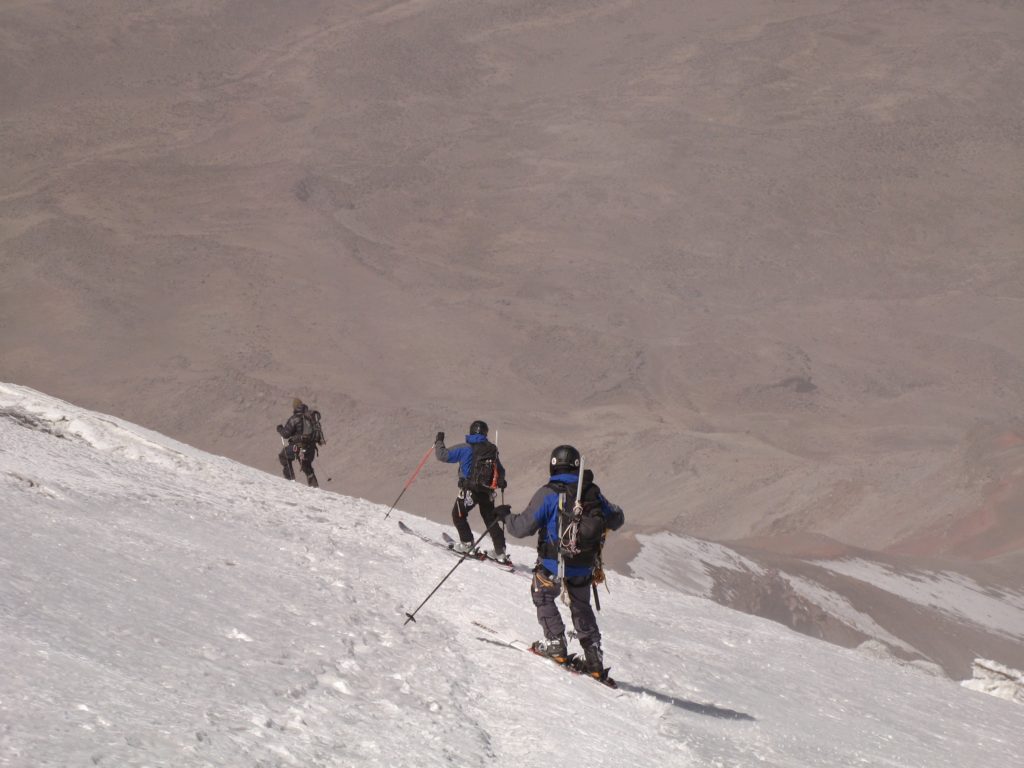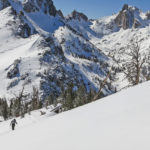Mike Marolt with the Illimani icefall in the background
In 2007, my identical twin brother Steve and buddy Jim Gile and I were departing Tibet after skiing Cho Oyu, and then climbing to just over 28,000 feet on Everest before the combination of a cold night on Everest and not climbing with supplemental oxygen presented major issues. The big concern was the reported bottleneck ahead on the second step. With feet already numb, the thought of standing in line for any time was a sure bet to lose toes, so we turned around. Common sense was respected, but in the back of our minds, the thought of standing in line to experience the highest peak had become very similar to the experience thousands of families have had at the Everest roller coaster at Disneyland. There had to be a better way to get our fix. In retrospect, we had spent over a decade honing our skills, gaining the experience to be able to realistically contemplate a peak like Everest without drugs, supplemental oxygen or Sherpa, and in the process were exposed to remote high peaks in South America where we saw few if any other people. The contrast on Everest was a wakeup call.
The three of us sat around one night drinking beer, wondering what to do next. The harebrained idea of climbing in the Himalaya in winter was an obvious choice; there would be no people at all, and it would offer us the ultimate challenges for ski mountaineering. This however, would entail a totally different skill set. The key to climbing the Himalaya in the winter is to be able to take on enormously big pushes avoiding camps and normal climbing schedules to avoid as much exposure from the intense cold combined with high altitude and thin air as possible. The goal is to eliminate as many camps as you can. With the exception of Everest, we had climbed Broad Peak, Shishapangma, and Cho Oyu by eliminating high camps, but we realized we had to step up our game for even larger pushes. Not knowing what we were capable of, we set out to attempt 6,000 meter peaks, taking them on with single day efforts with little acclimating. The idea was to find several peaks, and take them on progressively, a 5,000 foot day, then 6,000, and 7,000 and so on and so on. The goal was to figure out how hard and how fast we could safely push ourselves. South America was close, cheap, and would become our training ground.
In May 2009 we set out. The first peak on the agenda became a 21,000-foot active volcano we had never heard of in southern Peru, Coropuna. This was located opposite the more popular range of the Cordillera Blanca. There was literally no beta, and only after we found a way to get to the peak did locals in the village of Baraco explain that until the month before, they had never set eyes on white people. A Polish team of climbers had climbed the peak from their village and were the first known people to climb the peak from this side. We realized we were looking at a possible first ski descent. We found a local guide company who had a jeep and we set off not having a clue what we were in for.
After driving for several hours, we found ourselves off the beaten path on a dirt road on rarely seen deepest canyon in the world, Cotahuasi. This terrain made the Grand Canyon look benign! The road traversed out of the canyon and up the slopes heading to the objective, ending in the agricultural community of Baraco where our liaison introduced us to a local vaquero who had a couple of burros ready to take us to Coropuna. We spent the night and headed out the next morning finding our way on cattle trails. When the trails ended at a small creek, it looked like it came from the glacier up on Coropuna so we headed up. Eventually after getting lost a few times, common sense landed us just above a beautiful lagoon and grassy field at the foot of the peak at about 13,000 feet.
The next morning we packed up and headed up the peak. The terrain was rough pumice and sand, and at about 16,000 feet we found ourselves on a completely flat bench of pea gravel, a good place for a camp. This was our base camp as well as our high camp. From there, we could realize our first goal, a 5,000 foot summit day. There were no people on this side of the mountain, no trash, just a beautiful peak on the edge of the Atacama desert. Climber’s heaven!
We hauled the skis to 18,000 feet for a needed acclimation day, and then rested a day before setting off. Our push began at midnight with clear skies and perfect weather. We arrived at our ski cache just as the light started to hit the upper slopes, and we realized this was going to be a gem. We skinned the lower slopes to find the final 2000 feet avalanche prone, so we headed around the summit cone. The snow hardened and we ascended to the summit. Crevasses forced us to rope up, but the snow was hard, and outside of a high steep push to the summit, there were no major obstacles, with smooth snow slopes for what we knew would be an amazing ski.
Upon reaching the summit, we could feel every foot of the climb, and were exhausted, but at 21,000 feet, realized we could do more. We skied back to camp with near perfect hard snow up high and spring corn below, in the back of our minds ready to take the next steps and find a bit more.
We planned the next adventure for spring 2010, and decided 20,564 foot Chimborazo in Ecuador was the next objective. We had made an attempt on this peak several years before only to be turned around due to ice. The peak had a history of being a very popular peak in the 80’s with steep snow slopes, but in recent years, global warming and neighboring volcano eruptions had combined ash and sun hit to deteriorate climbing on the peak to serious business. Steep ice bulges with exposed slopes made crowds a thing of the past, and the peak had seen many years with no attempts. We packed ice gear and were going for broke. We had to finish what we started.
Arriving at the peak, the lower slopes were ugly. Obtaining the upper ridge would entail some scrambling on vertical ice ledges, but above that, the snow was white. We were the only people at the Whymper Hut at the base of the peak, and outside of a park ranger managing the vacant bunk house, there were only occasional tourists sightseeing at the base. The fore peak rose over 6,000 feet above us, and looking at the map, we realized we had to descend before obtaining the main summit. We reckoned we would have to climb nearly 7,000 feet to reach our goal, a massive day to altitude.
Using the tried and true method from Coropuna, to acclimate a bit we carried skis to about 17,000 feet just above a refugio used as the normal camp 1 to break the climb into two days. We descended back to the base of the peak, rested a day, and then set off at midnight.
The slopes gaining the main ridge were a jumbled mess of water ice steps cased with pumas gravel rendering our ice protection useless, and dulled our ice ax picks and crampon points. We literally scratched our way up on to the ridge exposed to cliffs and drops. It was some of the most difficult and sketchy alpine climbing we had ever done, all in the black of night.
On reaching the main ridge, we were above the rock face and rock debris, and were able to use our ice screws to protect the 45 degree ice slopes until we reached near perfect snow above. We easily climbed the face to the fore summit with miniature penitent flakes of smooth snow; in another week or two, these flakes would become 5-foot and unskiable shark’s teeth. Timing was perfect!
From the false summit, we looked across to the main summit, and to our surprise, the bergschrund of the crater which often prevents passage to the main summit was nonexistent. We were not looking forward to descending after the massive night of climbing, but we clicked into our skis and straight-lined down it to the main summit slope, and climbed the final steep pitch. Above that, as we dragged along the long flats to the summit, we were completely wasted. We were standing on the highest point on the equator, the highest active volcano in the world. We were as far from the center of the earth as is possible, even further than if standing on top of Everest. After a half hour of rest, hydration, and snapping some photos, we started our descent.
The skiing was on interesting but near effortless snow. We skied back to the ice and then slithered as far as we could, roping up to cross a few large crevasses. We down climbed the last few hundred feet of ice to the col. With the sun’s heat, rock fall was everywhere on the line of ascent below so we down climbed the ridge to talus slopes out of the line of fire. 13 hours after we started, we were exhausted but safely back at the refugio where we started. Our altimeters accumulated just under 7,000 feet of total climbing. After a failed attempt to climb and ski Chimborazo, we found success with one of the best high peaks skis in our lives. We were only the second people ever to ski from the main summit of the peak, and the only people to climb and ski the peak in a single day. We were satisfied, but knew we had enough left in our tanks to take things even further…
By spring 2012, we had managed to get our asses handed to us on our first winter Himalaya peak the previous January, and we needed an ego pump. We had made two previous attempts at 21,150 foot Illimani in Bolivia over a 16 year period, including one the year before, but despite a 100% success rate on a half dozen trips and numerous peaks in the area, Illimani for one reason or another had eluded us. We had unfinished business, and we were looking to further our training and experience to gain confidence needed for more winter Himalaya. We wanted to ski Illimani, but we wanted to do it with style.
We arrived in La Paz eager to get to the peak. La Paz International Airport is the highest international airport in the world at 14,000 feet, so after acclimating a day in the city, we set off. We jeeped to the village of Estancia Una where we met a local vaquero who loaded our gear on to mules for the pleasant walk to base camp. The base camp at Illimani sits on a ledge high above a canyon and at the foot of the peak. Camp is on flat grass at just under 14,000 feet and is fertilized and manicured by llama herds and small streams flowing from the massive glaciers of the peak making it look more like a golf course than a base camp. It is arguably the most beautiful base camp in the world. Going for skiing, we were at the camp a few weeks earlier than the climbing season, and we were completely alone!
Again, following the plan of Coropuna and Chimborazo, we spent the first day hauling skis to 18,000 feet, the normal camp 1 on the mountain in an effort to acclimate. We were still a couple miles from the route, and we carefully marked a trail with cairns knowing that we would have to negotiate this in the dark for a single day effort. The approach also entailed to large moraine ridges several hundred feet high that we had to climb up and down making it a tiresome approach. Eventually, the first section of the actual route entails a lot of scrambling on steep and exposed talus and rock, and was further complicated by an unusually large snow season that resulted in snow melt ice on many of the normally dry rock pitches. An old weathered sign at the start calls this “The Stairway to Heaven”. It was. Exposure on the narrow ridge had to be respected, but the views above the canyons back to La Paz were incredible! After caching the skis, we opted to rest for two days knowing that the approach and climb itself would entail the biggest effort of our careers. Realizing we were headed to 21,150 feet with little or no acclimation, those two rest days were full of nervous energy and we had to concentrate on not letting our minds get too crazy. We reasoned we could always turn around if we ran out of gas, but the thought of pulling this off was exciting.
Summit day started at 10pm in a silent trek. Our effort to mark the trail was rewarded with an uneventful approach with no time wasted finding our way. We ascended the Stairway to Heaven and made a decision to take advantage of the season’s low snow line to crampon up steep hard snow around much of the exposed rock which proved to be a more direct line saving a bit of time and eliminated exposure. This snow was too soft to ascend during the day, but at night the slopes were perfect hard snow for our crampons. We arrived at our ski cache an hour faster than expected.
At the cache, we roped up and were on new territory. We did our best to follow the ridge in the dark, passing over a couple knife ridges that only in the light of day we realized could have been avoided. Soon we were on the obvious slopes rising directly to the summit. Behind us, we could see the lights of La Paz and the Altiplano in the distance separated by deep darkness. The night was clear, calm and cold, perfect for climbing. With the first rays of the sun, we found ourselves at the steep 50 degree headwall. This was a possible obstacle to skiing in that it is generally an ice face. With the heavy snows, we were stoked to find perfect hard chalky snow! We easily climbed the 1,500 foot slope to the next hurdle, the summit bergschrund. Again, heavy snow created a solid ice bridge albeit very narrow, and soon we found ourselves on the gentle summit ridge.
The ridge seemed to go on forever. Steve and Jim were doing slightly better than me. I was as tired as I have ever been in the mountains, utterly gassed. I dug deep into my reserves, and vowed that nothing was going to stop me! I watched the rope snake away from me and requested that Steve on the front of the rope to slow the pace down. I then slowly followed it to the final summit. I was toast, but on the top, the adrenaline of pushing for 10 hours with no more climbing possible and the view with hard clear skies was powerful. I looked out at the lone summit of Bolivia’s highest peak Sajama, and memories of our ski descent of that peak, only its second ski descent ever, pumped me up! In a man-hug embrace, Jim said, “Boys, it’s been 16 years, but we did it!” With tears in our eyes we laughed at the thought of it….
We powered down some gels, clicked into our skis, and primed our ski legs on the gentle summit ridge. The snow was smooth chalk. I stopped above the ‘schrund, shot video of the boys skiing down, and then followed Steve as he carefully negotiated the precarious and steep snow bridge to the knoll just above the steep face. Skiing at that altitude after an effort like that was the most demanding skiing of our lives. We were just hammered. The snow was very skiable but did have a tricky crust, and on tired legs, we had to be careful. We negotiated large crevasses and steep knolls below the headwall and finally found ourselves at the ski cache.
At the cache, we rested for about 45 minutes realizing that descending the Stairway to Heaven under normal conditions could easily become a fall to hell without caution; being totally exhausted, we were concerned. We skied what we could but the snow had warmed too much so we down climbed the ridge, even putting in two belays to accommodate our tired state. After what seemed an eternity, we were at the bottom. Slowly we trekked back to camp, slowing to a snail’s pace on the long steep climbs up and over the moraines.
16 hours after we started, we were finally at base camp. Our altimeters registered 8,995 feet of total ascent. I dropped my pack, took off my boots, slammed a liter and a half of Coke, and slept until the next morning realizing the satisfaction of one of the biggest days of my life. We were only the second people ever to ski the peak. Few if any had ever climbed the peak in a single day, and none with skis.
We set out to test ourselves with one major objective in mind, to climb and ski in the winter Himalaya. In the process, by accepting the natural progression, the investment of time and effort mandatory in learning how far we could go, we gained an insight about something more important than a single goal. By being creative in the moment, we understood we could maximize every aspect of why we climbed and skied. Not only did our plan prepare us for climbing and skiing in the winter Himalaya, it provided us with some of the most satisfying moments in our career as well as some of our greatest personal achievements. The irony is, those achievements were never even remotely our goal. We flew home looking over Illimani, and etched forever in our minds were experiences we would never forget, and the satisfaction of knowing something about ourselves that otherwise we would have never realized.



















Beautiful pics and great job :)))